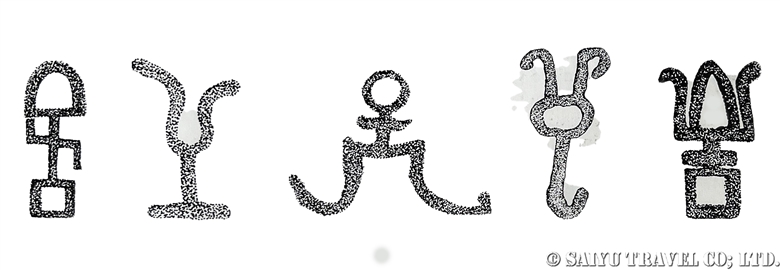
The Altar Rock at Thalpan is located on the sandy north bank of the Indus River. The rock is carved with motifs, mainly animal rather than Buddhist motifs. This is a fascinating example of Petroglyphs from the ancient Silk Road.
Since ancient times, Thalpan has had many visitors who come and go through this area. It was the nomads who first chose this site to carve. The rock face in front of the Alter Rock may have been used as a veritable ‘altar’, with various animals and slaughter scenes depicted.
These Petroglyphs with non-Buddhist motifs are thought to date from the mid-1st millennium BC.

One of the Petroglyphs that stands out on this Altar Rock is this image of a Warrior with Sacrifice. It appears to be a scene of a man slaughtering an animal (many sources call it a goat, but as an animal lover, it looks like an ibex to me). The figure of a Central Asian-style man holding a large knife is very distinctive.
The man’s dress is thought to be that of an equestrian nomad of the time, and it has been suggested that he may be from the Parthia, a dynasty that flourished on the Iranian plateau from the 3rd century BC to the 3rd century AD.
This animal sacrifice (or slaughter) Petroglyphs motif suggests that the influence of Central Asian peoples was stronger than the influence of Buddhism, which forbids the killing of animals.

This is a designed horse or unicorn with its forelegs bent at 45 degrees.
This pose, called “Knielauf,” was used in ancient Greece to depict a flying condition and was also popular in Achaemenid Persian art. The horse’s mane and tail are braided, giving them an appearance of bows.

Is it a designed ibex? The circular eyes are also an Iranian expression.

This shows a deer-like creature with antler and a predator with two tails chasing it. As a wildlife observer in Pakistan, it looks like a snow leopard attacking an ibex on a cliff to me. What is interesting, is that there is a head of a snake, at the end of the jagged line that also looks like a cliff.
One theory is that it shows an ibex in trouble, with a snake in front, a snow leopard behind, plus a hunter and his dogs, and nowhere to go.”
Such wavy designs are said to be a common feature of the art of the Altai region in southern Siberia.
The presence of Petroglyphs with Iranian elements at Altar Rock is not surprising, as Gandhara and Taxila were already satraps of the Achaemenid period. It is surprising that there was interaction between the Altai region of southern Siberia and this Indus region in the north, across one of the most mountainous regions in the world.
Petroglyphs from Thalpan Zyarat depict motifs from the Okunev culture of southern Siberia.

A large Buddha figure with a halo is seated with four smaller seated Buddha figures, also all with halos.
Each Buddha is in Dhayana Mudra sign and their garments cover their shoulders, with gracefully drawn parallel robe crests. Such garment crests are similar to designs found in the Gupta empire art, which flourished in India between AD 320 – 550.
A creature, possibly an ibex, is depicted on the same rock, and its movement and direction suggest that the ibex was carved first, and then the Buddha image was carved on top of it.

The west panel is also covered with Petroglyphs.
The Alter Rocks are the masterpieces of the Indus River Petroglyphs.
As we posted in previous blogs, it is such a shame that these rock carvings will be lost forever due to the construction of the dam.
Photo & text: Mariko SAWADA
*Contact us, Indus Caravan for more information or to make arrangements for visiting Rock carving along the Indus river.
*Please follow us on Youtube, Instagram & Facebook
Category : ◆ Gilgit-Baltistan > - Indus river bank > ◇ Rock carvings / PetroglyphTag : Silkroute , Chilas Rock Carving , Thalpan , Petroglyphs , Indus Petroglyphs , Alter Rock , Pakistan Blog , Diamer Basha Dam , #IndusPetroglyhs , Travel Pakistan Blog , silkroad , Indus Caravan , Rock Carving , Jataka , Saiyu Travel , Engraving , Pakistan tour operator , Buddhist remains , Indus river , Chilas








































